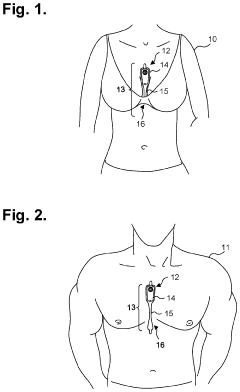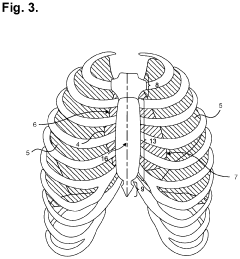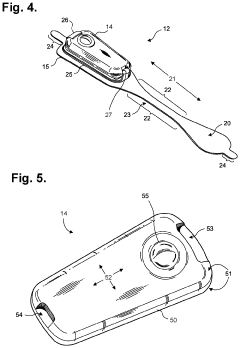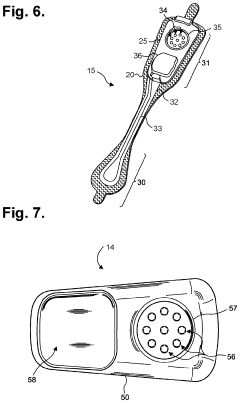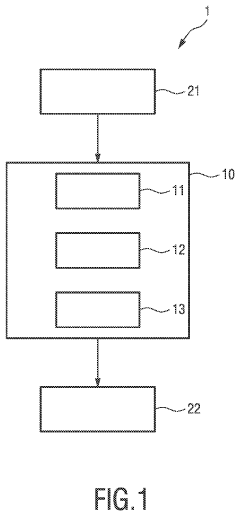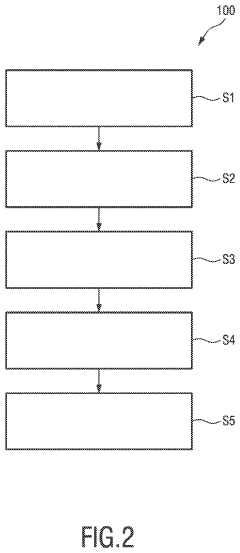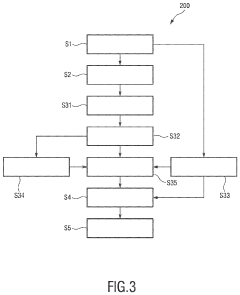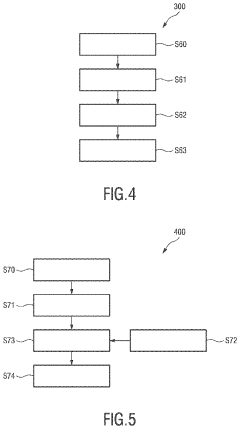Role of P wave in diagnosing pulmonary hypertension
AUG 19, 20259 MIN READ
Generate Your Research Report Instantly with AI Agent
Patsnap Eureka helps you evaluate technical feasibility & market potential.
P Wave Analysis Background and Objectives
The P wave, a crucial component of the electrocardiogram (ECG), represents atrial depolarization and has long been recognized as a valuable diagnostic tool in cardiology. In recent years, there has been growing interest in exploring the role of P wave analysis in diagnosing pulmonary hypertension (PH), a complex and often underdiagnosed condition characterized by elevated pressure in the pulmonary arteries.
The evolution of P wave analysis in the context of PH diagnosis can be traced back to early observations of right atrial enlargement in patients with pulmonary arterial hypertension. As our understanding of the pathophysiology of PH has advanced, so too has the sophistication of P wave analysis techniques. From simple measurements of P wave amplitude and duration, researchers have progressed to more nuanced assessments of P wave morphology, axis, and spatial characteristics.
The primary objective of P wave analysis in PH diagnosis is to identify early markers of right atrial remodeling and dysfunction, which often precede more overt clinical manifestations of the disease. By detecting subtle changes in atrial electrical activity, clinicians aim to improve the early detection and risk stratification of patients with suspected PH. This non-invasive approach holds particular promise in screening high-risk populations and monitoring disease progression over time.
Recent technological advancements have further expanded the potential of P wave analysis in PH diagnosis. High-resolution ECG recording systems, advanced signal processing algorithms, and machine learning techniques have enabled more precise and comprehensive evaluation of P wave characteristics. These innovations have paved the way for the development of novel P wave-derived parameters and risk prediction models specific to PH.
The integration of P wave analysis into the diagnostic workup for PH aligns with the broader trend towards personalized medicine and risk-based patient management. By combining P wave data with other clinical, imaging, and biochemical markers, researchers aim to create more accurate and individualized diagnostic and prognostic tools for PH. This multifaceted approach reflects the complex nature of the disease and the need for comprehensive assessment strategies.
As research in this field continues to evolve, several key objectives have emerged. These include standardizing P wave analysis methodologies across different ECG platforms, validating P wave-derived parameters in large, diverse patient cohorts, and establishing clear thresholds for clinical decision-making. Additionally, there is a growing focus on elucidating the mechanistic links between P wave abnormalities and the underlying pathophysiology of PH, which could potentially inform new therapeutic targets and strategies.
The evolution of P wave analysis in the context of PH diagnosis can be traced back to early observations of right atrial enlargement in patients with pulmonary arterial hypertension. As our understanding of the pathophysiology of PH has advanced, so too has the sophistication of P wave analysis techniques. From simple measurements of P wave amplitude and duration, researchers have progressed to more nuanced assessments of P wave morphology, axis, and spatial characteristics.
The primary objective of P wave analysis in PH diagnosis is to identify early markers of right atrial remodeling and dysfunction, which often precede more overt clinical manifestations of the disease. By detecting subtle changes in atrial electrical activity, clinicians aim to improve the early detection and risk stratification of patients with suspected PH. This non-invasive approach holds particular promise in screening high-risk populations and monitoring disease progression over time.
Recent technological advancements have further expanded the potential of P wave analysis in PH diagnosis. High-resolution ECG recording systems, advanced signal processing algorithms, and machine learning techniques have enabled more precise and comprehensive evaluation of P wave characteristics. These innovations have paved the way for the development of novel P wave-derived parameters and risk prediction models specific to PH.
The integration of P wave analysis into the diagnostic workup for PH aligns with the broader trend towards personalized medicine and risk-based patient management. By combining P wave data with other clinical, imaging, and biochemical markers, researchers aim to create more accurate and individualized diagnostic and prognostic tools for PH. This multifaceted approach reflects the complex nature of the disease and the need for comprehensive assessment strategies.
As research in this field continues to evolve, several key objectives have emerged. These include standardizing P wave analysis methodologies across different ECG platforms, validating P wave-derived parameters in large, diverse patient cohorts, and establishing clear thresholds for clinical decision-making. Additionally, there is a growing focus on elucidating the mechanistic links between P wave abnormalities and the underlying pathophysiology of PH, which could potentially inform new therapeutic targets and strategies.
Clinical Demand for PH Diagnosis
Pulmonary hypertension (PH) is a serious and progressive condition characterized by elevated blood pressure in the pulmonary arteries. The clinical demand for accurate and early diagnosis of PH is significant due to its impact on patient outcomes and quality of life. Currently, the gold standard for diagnosing PH is right heart catheterization (RHC), an invasive procedure that carries inherent risks and is not suitable for routine screening or follow-up.
The medical community has long sought non-invasive alternatives for PH diagnosis, leading to increased interest in the role of electrocardiographic (ECG) parameters, particularly the P wave. The P wave, representing atrial depolarization, has shown promise as a potential biomarker for PH due to its sensitivity to changes in right atrial pressure and size.
The demand for improved PH diagnostic methods stems from several factors. Firstly, PH is often underdiagnosed or diagnosed late in its course, leading to delayed treatment and poorer outcomes. Early detection could significantly improve patient prognosis and management strategies. Secondly, the prevalence of PH is increasing, particularly in aging populations and those with comorbidities such as chronic obstructive pulmonary disease (COPD) and sleep apnea.
Healthcare providers require more accessible and cost-effective screening tools to identify patients at risk of PH. The P wave analysis offers a potential solution, as ECGs are widely available, non-invasive, and relatively inexpensive. This approach could enable broader screening programs and more frequent monitoring of at-risk populations.
Moreover, there is a growing need for methods to assess PH severity and monitor disease progression without repeated invasive procedures. If P wave characteristics can reliably correlate with pulmonary artery pressure, it could provide a valuable tool for ongoing patient management and treatment optimization.
The pharmaceutical industry also has a vested interest in improved PH diagnostics. As new therapies for PH are developed, more accurate and accessible diagnostic tools are needed for patient selection in clinical trials and to monitor treatment efficacy in real-world settings.
Lastly, the push towards personalized medicine has increased the demand for biomarkers that can help stratify PH patients and guide individualized treatment approaches. The P wave, if proven to be a reliable indicator, could contribute to this goal by providing additional information about the underlying cardiac adaptations in PH.
In conclusion, the clinical demand for improved PH diagnosis is driven by the need for early detection, non-invasive monitoring, and better patient stratification. The potential role of the P wave in meeting these needs has generated significant interest and warrants further investigation to validate its clinical utility in the diagnosis and management of pulmonary hypertension.
The medical community has long sought non-invasive alternatives for PH diagnosis, leading to increased interest in the role of electrocardiographic (ECG) parameters, particularly the P wave. The P wave, representing atrial depolarization, has shown promise as a potential biomarker for PH due to its sensitivity to changes in right atrial pressure and size.
The demand for improved PH diagnostic methods stems from several factors. Firstly, PH is often underdiagnosed or diagnosed late in its course, leading to delayed treatment and poorer outcomes. Early detection could significantly improve patient prognosis and management strategies. Secondly, the prevalence of PH is increasing, particularly in aging populations and those with comorbidities such as chronic obstructive pulmonary disease (COPD) and sleep apnea.
Healthcare providers require more accessible and cost-effective screening tools to identify patients at risk of PH. The P wave analysis offers a potential solution, as ECGs are widely available, non-invasive, and relatively inexpensive. This approach could enable broader screening programs and more frequent monitoring of at-risk populations.
Moreover, there is a growing need for methods to assess PH severity and monitor disease progression without repeated invasive procedures. If P wave characteristics can reliably correlate with pulmonary artery pressure, it could provide a valuable tool for ongoing patient management and treatment optimization.
The pharmaceutical industry also has a vested interest in improved PH diagnostics. As new therapies for PH are developed, more accurate and accessible diagnostic tools are needed for patient selection in clinical trials and to monitor treatment efficacy in real-world settings.
Lastly, the push towards personalized medicine has increased the demand for biomarkers that can help stratify PH patients and guide individualized treatment approaches. The P wave, if proven to be a reliable indicator, could contribute to this goal by providing additional information about the underlying cardiac adaptations in PH.
In conclusion, the clinical demand for improved PH diagnosis is driven by the need for early detection, non-invasive monitoring, and better patient stratification. The potential role of the P wave in meeting these needs has generated significant interest and warrants further investigation to validate its clinical utility in the diagnosis and management of pulmonary hypertension.
Current P Wave Analysis Techniques and Limitations
Current P wave analysis techniques for diagnosing pulmonary hypertension primarily focus on electrocardiographic (ECG) measurements and interpretations. The most commonly used method involves examining the P wave amplitude and duration in lead II of a standard 12-lead ECG. In this approach, a P wave amplitude exceeding 2.5 mm in lead II is considered suggestive of right atrial enlargement, which is often associated with pulmonary hypertension.
Another widely employed technique is the analysis of P wave axis. A rightward shift of the P wave axis, typically greater than 75 degrees, can indicate right atrial abnormality and is frequently observed in patients with pulmonary hypertension. This method requires careful examination of P wave morphology across multiple ECG leads.
Advanced P wave analysis techniques include the evaluation of P wave terminal force in lead V1 (PTFV1). This involves measuring the duration and amplitude of the terminal negative portion of the P wave in lead V1. A PTFV1 greater than 0.04 mm·s is considered abnormal and may suggest left atrial enlargement, which can be associated with pulmonary hypertension in some cases.
Despite these established techniques, several limitations exist in current P wave analysis methods for diagnosing pulmonary hypertension. One significant challenge is the low sensitivity and specificity of P wave criteria when used in isolation. P wave changes can be subtle and may not always correlate directly with the severity of pulmonary hypertension.
Inter-observer variability presents another limitation, as the interpretation of P wave morphology can be subjective and dependent on the experience of the clinician. This variability can lead to inconsistencies in diagnosis and potential misclassification of patients.
The influence of other cardiac conditions on P wave morphology also poses a challenge. Conditions such as atrial fibrillation, atrial flutter, or conduction abnormalities can alter P wave characteristics, making it difficult to isolate changes specifically related to pulmonary hypertension.
Furthermore, the reliance on standard 12-lead ECG recordings may not capture the full complexity of atrial electrical activity. More advanced techniques, such as P wave signal-averaged ECG or body surface potential mapping, could potentially provide more detailed information but are not widely available in clinical practice.
Lastly, the dynamic nature of pulmonary pressures and the potential for adaptive changes in atrial structure over time can limit the reliability of P wave analysis as a standalone diagnostic tool for pulmonary hypertension. These factors underscore the need for integrating P wave analysis with other clinical and imaging modalities to improve diagnostic accuracy and reliability in assessing pulmonary hypertension.
Another widely employed technique is the analysis of P wave axis. A rightward shift of the P wave axis, typically greater than 75 degrees, can indicate right atrial abnormality and is frequently observed in patients with pulmonary hypertension. This method requires careful examination of P wave morphology across multiple ECG leads.
Advanced P wave analysis techniques include the evaluation of P wave terminal force in lead V1 (PTFV1). This involves measuring the duration and amplitude of the terminal negative portion of the P wave in lead V1. A PTFV1 greater than 0.04 mm·s is considered abnormal and may suggest left atrial enlargement, which can be associated with pulmonary hypertension in some cases.
Despite these established techniques, several limitations exist in current P wave analysis methods for diagnosing pulmonary hypertension. One significant challenge is the low sensitivity and specificity of P wave criteria when used in isolation. P wave changes can be subtle and may not always correlate directly with the severity of pulmonary hypertension.
Inter-observer variability presents another limitation, as the interpretation of P wave morphology can be subjective and dependent on the experience of the clinician. This variability can lead to inconsistencies in diagnosis and potential misclassification of patients.
The influence of other cardiac conditions on P wave morphology also poses a challenge. Conditions such as atrial fibrillation, atrial flutter, or conduction abnormalities can alter P wave characteristics, making it difficult to isolate changes specifically related to pulmonary hypertension.
Furthermore, the reliance on standard 12-lead ECG recordings may not capture the full complexity of atrial electrical activity. More advanced techniques, such as P wave signal-averaged ECG or body surface potential mapping, could potentially provide more detailed information but are not widely available in clinical practice.
Lastly, the dynamic nature of pulmonary pressures and the potential for adaptive changes in atrial structure over time can limit the reliability of P wave analysis as a standalone diagnostic tool for pulmonary hypertension. These factors underscore the need for integrating P wave analysis with other clinical and imaging modalities to improve diagnostic accuracy and reliability in assessing pulmonary hypertension.
Existing P Wave Analysis Methods for PH
01 P wave detection and analysis in ECG signals
Methods and systems for detecting and analyzing P waves in electrocardiogram (ECG) signals. These techniques involve identifying P wave characteristics, such as amplitude, duration, and morphology, to assess cardiac function and diagnose various heart conditions.- P wave detection and analysis in ECG signals: Methods and systems for detecting and analyzing P waves in electrocardiogram (ECG) signals. These techniques involve signal processing algorithms to identify, isolate, and characterize P waves, which represent atrial depolarization. The analysis of P waves can provide valuable information about cardiac health and potential abnormalities in the heart's electrical activity.
- P wave-based arrhythmia detection: Techniques for detecting and classifying cardiac arrhythmias based on P wave characteristics. These methods involve analyzing P wave morphology, timing, and variability to identify various types of arrhythmias, such as atrial fibrillation or atrial flutter. The analysis can be used in implantable cardiac devices or external monitoring systems for early detection and treatment of heart rhythm disorders.
- P wave signal processing in communication systems: Methods for processing P waves in communication systems, particularly in wireless and optical communications. These techniques involve modulation, demodulation, and filtering of P waves to improve signal quality, reduce interference, and enhance data transmission efficiency. The applications range from mobile networks to fiber-optic communications.
- P wave-based cardiac pacing and therapy: Systems and methods for cardiac pacing and therapy based on P wave analysis. These techniques involve using P wave characteristics to optimize the timing and delivery of pacing pulses in implantable cardiac devices. The goal is to improve cardiac function, synchronize atrial and ventricular contractions, and manage various heart conditions more effectively.
- P wave monitoring in wearable devices: Integration of P wave monitoring capabilities in wearable devices for continuous cardiac health assessment. These technologies involve miniaturized sensors and advanced algorithms to detect and analyze P waves in real-time, providing users with insights into their heart rhythm and potential cardiac issues. The wearable devices can alert users and healthcare providers to abnormalities in P wave patterns.
02 P wave signal processing in communication systems
Techniques for processing P wave signals in communication systems, including modulation, demodulation, and filtering methods. These approaches aim to improve signal quality, reduce interference, and enhance overall system performance in wireless and wired communication networks.Expand Specific Solutions03 P wave analysis for seismic exploration
Methods for analyzing P waves in seismic exploration to gather information about subsurface structures and geological formations. These techniques involve processing and interpreting P wave data to identify potential oil and gas reservoirs or other valuable resources.Expand Specific Solutions04 P wave-based medical diagnostics and monitoring
Applications of P wave analysis in medical diagnostics and patient monitoring, including the development of algorithms and devices for detecting cardiac abnormalities, assessing heart rhythm disorders, and predicting potential cardiac events based on P wave characteristics.Expand Specific Solutions05 P wave propagation modeling and simulation
Techniques for modeling and simulating P wave propagation in various media, including the development of computational methods and software tools to predict and analyze P wave behavior in complex environments such as the Earth's crust or biological tissues.Expand Specific Solutions
Key Players in ECG and PH Research
The role of P waves in diagnosing pulmonary hypertension is an emerging area of research in the cardiovascular field. The market for this technology is still in its early stages, with a growing interest from both academic institutions and medical device companies. Key players like Bardy Diagnostics, Koninklijke Philips, and United Therapeutics are investing in research and development to improve diagnostic accuracy. The technology's maturity is progressing, with companies like Edan Instruments and Youjiali developing ECG-assisted analysis tools. However, widespread clinical adoption is still limited, indicating potential for market growth. As the understanding of P wave analysis in pulmonary hypertension diagnosis advances, collaborations between universities, hospitals, and industry leaders are likely to drive innovation and market expansion.
Koninklijke Philips NV
Technical Solution: Philips has developed advanced ECG algorithms for P wave analysis in pulmonary hypertension diagnosis. Their technology utilizes machine learning to detect subtle P wave changes, including increased P wave amplitude and duration[1]. The system integrates with their cardiovascular imaging solutions, allowing for comprehensive assessment of right heart function[2]. Philips' approach combines ECG data with echocardiography and cardiac MRI for a multi-modal diagnosis strategy, improving accuracy in detecting early-stage pulmonary hypertension[3].
Strengths: Comprehensive multi-modal approach, advanced machine learning algorithms. Weaknesses: Reliance on multiple imaging modalities may increase cost and complexity.
Edan Instruments, Inc.
Technical Solution: Edan Instruments has developed specialized ECG devices for P wave analysis in pulmonary hypertension diagnosis. Their technology focuses on high-resolution signal acquisition and advanced filtering techniques to enhance P wave visibility[10]. Edan's systems incorporate automated P wave measurement tools, including P wave area and axis calculation[11]. The company has also introduced portable ECG devices with built-in pulmonary hypertension screening algorithms, suitable for use in various clinical settings[12].
Strengths: High-resolution signal acquisition, automated P wave measurements, portable screening devices. Weaknesses: May require specialized training for optimal use and interpretation.
Innovative P Wave Parameters for PH Detection
Moisture-resistant electrocardiography monitor
PatentActiveUS20230301576A1
Innovation
- A lightweight, wearable electrocardiography monitor with a flexible extended wear electrode patch and a reusable recorder that can be easily positioned on the sternal midline, optimized for sensing cardiac electrical potentials, including P-waves, and designed for extended wear with patient-friendly replacement and moisture resistance.
Device, system and method for determining pulse pressure variation of a subject
PatentPendingUS20230000369A1
Innovation
- A device and method that derive a pulse height signal, extract a baseline, and compute PPV by subtracting the baseline from the pulse height signal, using a band pass filter to suppress noise and focus on ventilation-induced components, thereby improving the accuracy of PPV computation.
Regulatory Aspects of ECG-Based PH Diagnosis
The regulatory landscape for ECG-based pulmonary hypertension (PH) diagnosis is complex and evolving. Regulatory bodies, such as the FDA in the United States and the EMA in Europe, play crucial roles in overseeing the development, approval, and implementation of diagnostic tools for PH.
These agencies have established guidelines for the validation and clinical use of ECG-based diagnostic methods, including those utilizing P wave analysis. The FDA, for instance, requires rigorous clinical trials and substantial evidence of safety and efficacy before approving any new diagnostic tool. This process typically involves multiple phases of clinical studies, from initial proof-of-concept to large-scale validation trials.
Regulatory considerations also extend to the quality control and standardization of ECG equipment and analysis software. Manufacturers must adhere to strict quality management systems and demonstrate compliance with international standards, such as ISO 13485 for medical devices. This ensures consistency and reliability in ECG measurements across different healthcare settings.
Data privacy and security regulations, such as HIPAA in the US and GDPR in Europe, significantly impact the development and implementation of ECG-based PH diagnostic tools. These regulations mandate strict protocols for handling patient data, including ECG recordings and analysis results, to protect patient confidentiality and ensure ethical use of medical information.
Reimbursement policies and healthcare system integration are other critical regulatory aspects. For widespread adoption, ECG-based PH diagnostic methods must navigate complex reimbursement landscapes, which vary significantly across different countries and healthcare systems. Regulatory bodies often work in conjunction with health technology assessment agencies to evaluate the cost-effectiveness and clinical utility of new diagnostic approaches.
As the field of ECG-based PH diagnosis advances, regulatory frameworks are adapting to accommodate innovative technologies. This includes the development of specific guidelines for AI-enhanced ECG analysis and the use of machine learning algorithms in diagnostic tools. Regulatory bodies are increasingly focusing on the validation of these advanced analytical methods, ensuring their reliability and transparency in clinical decision-making.
These agencies have established guidelines for the validation and clinical use of ECG-based diagnostic methods, including those utilizing P wave analysis. The FDA, for instance, requires rigorous clinical trials and substantial evidence of safety and efficacy before approving any new diagnostic tool. This process typically involves multiple phases of clinical studies, from initial proof-of-concept to large-scale validation trials.
Regulatory considerations also extend to the quality control and standardization of ECG equipment and analysis software. Manufacturers must adhere to strict quality management systems and demonstrate compliance with international standards, such as ISO 13485 for medical devices. This ensures consistency and reliability in ECG measurements across different healthcare settings.
Data privacy and security regulations, such as HIPAA in the US and GDPR in Europe, significantly impact the development and implementation of ECG-based PH diagnostic tools. These regulations mandate strict protocols for handling patient data, including ECG recordings and analysis results, to protect patient confidentiality and ensure ethical use of medical information.
Reimbursement policies and healthcare system integration are other critical regulatory aspects. For widespread adoption, ECG-based PH diagnostic methods must navigate complex reimbursement landscapes, which vary significantly across different countries and healthcare systems. Regulatory bodies often work in conjunction with health technology assessment agencies to evaluate the cost-effectiveness and clinical utility of new diagnostic approaches.
As the field of ECG-based PH diagnosis advances, regulatory frameworks are adapting to accommodate innovative technologies. This includes the development of specific guidelines for AI-enhanced ECG analysis and the use of machine learning algorithms in diagnostic tools. Regulatory bodies are increasingly focusing on the validation of these advanced analytical methods, ensuring their reliability and transparency in clinical decision-making.
Cost-Effectiveness of P Wave Analysis in PH Screening
The cost-effectiveness of P wave analysis in pulmonary hypertension (PH) screening is a critical consideration for healthcare systems and policymakers. This analysis aims to evaluate the economic impact and clinical benefits of incorporating P wave assessment into PH screening protocols.
P wave analysis, as a non-invasive electrocardiographic technique, offers potential advantages in terms of accessibility and reduced costs compared to more invasive diagnostic procedures. The initial investment in ECG equipment and training for healthcare providers is relatively low, making it an attractive option for widespread implementation in primary care settings.
Studies have shown that P wave analysis can improve the early detection of PH, potentially leading to earlier interventions and improved patient outcomes. This early identification may result in reduced hospitalizations and decreased long-term healthcare costs associated with advanced PH management. However, the specificity and sensitivity of P wave analysis in PH diagnosis must be carefully considered to avoid unnecessary follow-up tests and associated costs.
A comprehensive cost-effectiveness analysis should consider the direct costs of implementing P wave analysis, including equipment, training, and interpretation time, as well as the potential savings from early detection and intervention. Additionally, indirect costs such as reduced work productivity and quality of life improvements should be factored into the overall economic assessment.
Comparative studies with other screening methods, such as echocardiography or biomarker testing, are essential to determine the relative cost-effectiveness of P wave analysis. These comparisons should account for factors such as accuracy, accessibility, and patient acceptability.
The scalability of P wave analysis in PH screening is another crucial factor in its cost-effectiveness. The potential for widespread implementation in various healthcare settings, including rural and underserved areas, could significantly impact overall healthcare costs and improve access to early PH detection.
Long-term follow-up studies are needed to fully assess the economic impact of P wave analysis in PH screening. These studies should evaluate the reduction in PH-related complications, hospitalizations, and mortality rates attributable to early detection through P wave analysis.
In conclusion, while P wave analysis shows promise as a cost-effective tool for PH screening, further research and real-world implementation data are necessary to definitively establish its economic value in various healthcare systems and patient populations.
P wave analysis, as a non-invasive electrocardiographic technique, offers potential advantages in terms of accessibility and reduced costs compared to more invasive diagnostic procedures. The initial investment in ECG equipment and training for healthcare providers is relatively low, making it an attractive option for widespread implementation in primary care settings.
Studies have shown that P wave analysis can improve the early detection of PH, potentially leading to earlier interventions and improved patient outcomes. This early identification may result in reduced hospitalizations and decreased long-term healthcare costs associated with advanced PH management. However, the specificity and sensitivity of P wave analysis in PH diagnosis must be carefully considered to avoid unnecessary follow-up tests and associated costs.
A comprehensive cost-effectiveness analysis should consider the direct costs of implementing P wave analysis, including equipment, training, and interpretation time, as well as the potential savings from early detection and intervention. Additionally, indirect costs such as reduced work productivity and quality of life improvements should be factored into the overall economic assessment.
Comparative studies with other screening methods, such as echocardiography or biomarker testing, are essential to determine the relative cost-effectiveness of P wave analysis. These comparisons should account for factors such as accuracy, accessibility, and patient acceptability.
The scalability of P wave analysis in PH screening is another crucial factor in its cost-effectiveness. The potential for widespread implementation in various healthcare settings, including rural and underserved areas, could significantly impact overall healthcare costs and improve access to early PH detection.
Long-term follow-up studies are needed to fully assess the economic impact of P wave analysis in PH screening. These studies should evaluate the reduction in PH-related complications, hospitalizations, and mortality rates attributable to early detection through P wave analysis.
In conclusion, while P wave analysis shows promise as a cost-effective tool for PH screening, further research and real-world implementation data are necessary to definitively establish its economic value in various healthcare systems and patient populations.
Unlock deeper insights with Patsnap Eureka Quick Research — get a full tech report to explore trends and direct your research. Try now!
Generate Your Research Report Instantly with AI Agent
Supercharge your innovation with Patsnap Eureka AI Agent Platform!
